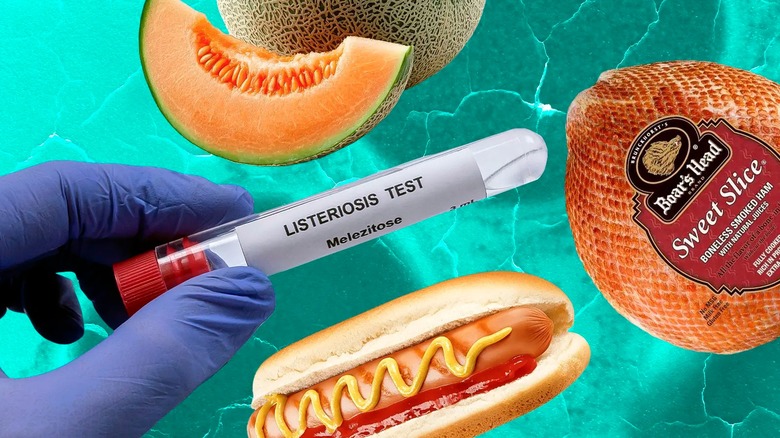5 Of The Worst Listeria Outbreaks In US History
When it comes to learning cooking basics, some of the most important lessons are those involving food safety. That includes everything from being familiar with proper cooking temperatures to knowing whether or not you should throw out that food that's possibly been in the fridge a little too long, but sometimes, the danger lurking in your food had nothing to do with you.
Food safety organizations like the U.S. Food & Drug Administration regularly issue recalls for products found to be contaminated with the pathogens that cause food poisoning, and while things like meat might come to mind first as being among the biggest offenders, nationwide recalls have also been issued for items like produce and even ice cream. In 2024, multiple ice cream brands were recalled for a listeria risk, and listeria is nothing to mess around with.
Listeria is a bacterial infection that can cause fever, chills, gastrointestinal distress, and in extreme cases, it can be deadly. Those most at risk for developing severe, life-threatening illnesses include those who are pregnant, newborn infants, anyone with a compromised immune system, and anyone over the age of 65. In late 2024, the U.S. found itself in the midst of a major outbreak, with around 10 million pounds of meat and poultry from BrucePac being recalled for listeria risk. Shockingly, that wasn't even one of the worst listeria outbreaks in U.S. history, so let's take a closer look at some of the deadliest.
Boar's Head listeria outbreak (2024)
By August 2024, the listeria outbreak that had been linked to Boar's Head deli meats had become the worst that the nation had seen in more than a decade. At the time of this writing, the Centers for Disease Control and Prevention was reporting that the 19-state, months-long outbreak had resulted in 59 cases, 59 hospitalizations, and 10 deaths. Seven million pounds of meat were impacted by a recall that impacted products manufactured in June and July, had sell-by dates as late as October, and since listeria has as long as a 10-week incubation period, that presented a massive problem.
The outbreak was linked to a factory in Jarratt, Virginia, and started with contaminated liverwurst. However, the outbreak was further connected to 70 other meat products. Consumers were instructed to check any meat products for the number "12612" on the inspection label, throw away any recalled products, and thoroughly clean anything that those products came into contact with.
An investigation into the factory where the contaminated meat products were manufactured was the stuff of nightmares, and the USDA discovered health code violations that weren't limited to mold and mildew on equipment, puddles of blood, improperly cleaned equipment with spoiled meat still on it, and contaminants dripping from the ceiling onto the production floor. Reports also suggest the violations were routine problems at the factory, and multiple lawsuits have been filed against the company for wrongful death and negligence (among other charges).
Multi-state cantaloupe listeria outbreak (2011)
The 2024 listeria outbreak linked to Boar's Head had the dubious honor of being the worst that the nation had seen since 2011 when there was a massive outbreak linked to cantaloupe sourced from Jensen Farms in Colorado. According to the Centers for Disease Control and Prevention, there were officially 147 cases, 143 hospitalizations, and 33 deaths that occurred in 28 different states.
The outbreak occurred between August and October, and the investigation that followed determined that it could be traced back to the processing center and a change to equipment that happened in May of that same year. Cantaloupes were harvested and packaged without being treated with an antibacterial agent, a crucial step in the process that would have gotten rid of any bacteria on the fruits. It was also found that pooling water and unsanitary conditions contributed to the outbreak, and in addition to the widespread illnesses and the death toll, area agricultural organizations reported that all farmers in the area were impacted by the warning, even though it was linked to a single farm.
In 2014, the two brothers who ran Jensen Farms were sentenced to five years of probation, 100 hours of community service, six months of in-home detention, and were given a $150,000 fine. The brothers issued a statement apologizing for the oversight, and at the time, it was the third deadliest listeria outbreak in the country's history. Fruits remain a listeria risk, with peaches, plums, and nectarines recalled in 2023.
Pilgrim's Pride/Jack Lambersky poultry listeria outbreak (2002)
In 2002, Pilgrim's Pride announced that it was recalling 295,000 pounds of turkey and chicken, and that's when things got complicated. When investigators isolated the strain of listeria that was discovered in the Pilgrim's Pride Pennsylvania plant, they were unable to link it definitively to an in-progress listeria outbreak. At about the same time, another poultry producer in New Jersey, Jack Lambersky Poultry Company Inc., also issued a massive recall for listeria. By the time that was done, they recalled about four million pounds of meat, and when that listeria strain was isolated, investigators found that there was no way to tell the two apart.
By the time the outbreak ended, 11 were dead — including three fetal deaths — and 54 people had fallen ill across nine states. Pilgrim's Pride ended up recalling around 27 million pounds of potentially contaminated meat, and there's a strange end to this story.
Pilgrim's Pride ended up being sued in several wrongful death cases, and although it settled those cases, the company also issued an official statement saying that they maintained the recalled meat was not actually responsible for the deaths or the illnesses, and the settlement in the case was done in order to just put an end to the matter instead of dragging things out through the courts. Jack Lambersky Poultry was also taken to court, but the outcome is unclear.
Listeria outbreak associated with hot dogs (1998-1999)
The final numbers for the listeria outbreak that lasted from August 1998 to January 1999 are difficult to read: There were 108 cases across 24 states, and in addition to 14 deaths, there were also four fetal deaths associated with the outbreak. (Some sources cite 15 deaths and six fetal deaths.)
The outbreak was traced back to hot dogs that were sold under a variety of brand names, including Grillmaster, Ball Park, Mr. Turkey, and Hygrade. The listeria-tainted hot dogs came from a Bil Mar plant just outside of Grand Rapids, Michigan, and interestingly, it was almost immediately reported that the particular strain of listeria was easily identifiable by a unique DNA structure. The source of the contamination was less clear, and around 15 million pounds of deli meat and hot dogs were recalled.
Parent company Sara Lee invested an almost shocking amount of money in trying to set things right, including a $25 million overhaul at the plant linked to the source of the contamination, and around $4 million in donations to Georgetown and Michigan State universities for research into food safety. They also settled a series of lawsuits that suggested many more people were sickened in the outbreak than the official illness and death toll numbers.
Jalisco Products cheese listeria outbreak (1985)
Reports on a listeria outbreak that happened from January to August 1985 are unsettling. By the time it was over, there were 142 cases identified and 48 were dead. That included 18 adults, 10 newborns, and 20 fetal deaths. The source of the outbreak was found to be a Mexican-style soft cheese — including cotija and queso fresco — from Jalisco Mexican Projects Inc., which was accused of using unpasteurized milk in the manufacturing process. In addition, milk that was pasteurized at the Jalisco plant was found to be overseen by employees not authorized in the process.
The scale of the outbreak isn't really known. Although most of the cheese connected to the outbreak was sold in California, it was also distributed across multiple states. There were also multiple batches of cheese with different expiration dates that were found to be contaminated, suggesting that it wasn't an isolated case, incident, or problem. The death toll also varies, with The New York Times reporting in 1985 that there were 62 deaths that had been linked to Jalisco, which was — at the time — denying any wrongdoing.
Jalisco's owner, Gary McPherson, ended up serving a 30-day jail sentence. Between $48,000 in fines and insurance money, it was found that it wasn't enough to compensate the large number of victims, and no one really walked away feeling as though justice had been done. Jalisco closed, and there were a number of reforms in the cheese and dairy industry — including stricter regulations in cheese-making.





